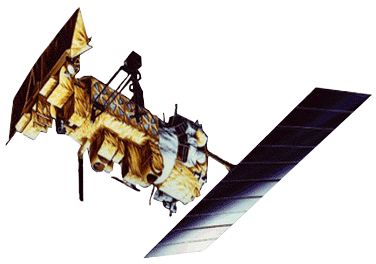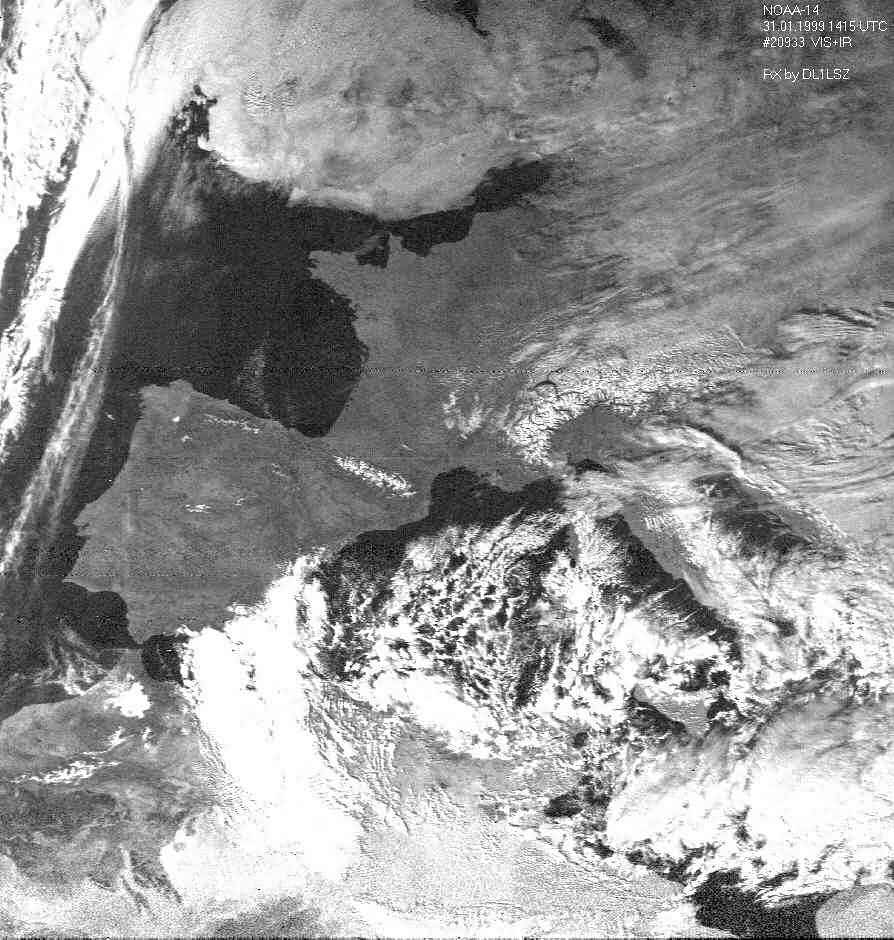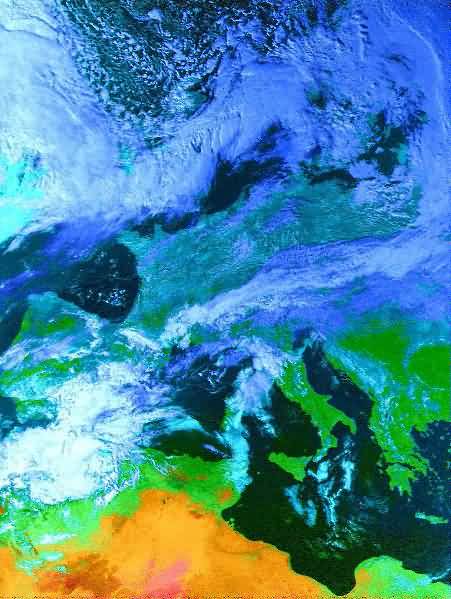
NOAA-14 wurde am 30.12.1994 von Vandenberg Californien gestartet und umkreist die Erde in ca. 870 km Höhe auf einer sonnensynchronen Bahn. Deshalb sind die Satelliten immer zur gleichen Tages- bzw. Nachtzeit zu empfangen. Die Inklination beträgt ca. 98°, die Umlaufzeit 101 Minuten.
 so klingt das APT-Signal eines NOAA-Satelliten (137 MHz)
so klingt das APT-Signal eines NOAA-Satelliten (137 MHz)
detaillierte Beschreibungen
Übersicht / Grundlagen der NOAA-Serie (NOAA Instrumente)
Die Empfangsanlage für APT Aussendungen der Wettersatelliten
APT- und HRPT Aussendung der NOAA Satelliten
NOAA APT Bildverarbeitung
NASA Catalog: 23455
Downlink
APT: 137.62 MHz
HRPT: 1701.0 MHz
Status
ausser Betrieb
Logbuch und aktuelle Informationen
A few hours after launch, a GN 2 regulator valve leak caused the spacecraft to experience an attitude anomaly. The satellite was recovered within hours and remains in a stable orbit. In January 1995, it was determined that one of the four Space Environment Monitor (SEM) telescopes was inoperative, reducing data collected by 12 percent. In February 1995, the SARP failed, the SBUV/2 Cloud Cover Radiometer (CCR) failed, and DTR 4A/4B was deemed inoperable. Also, the ESA exhibited high Quadrant 3 (Q3) data counts due to apparent contamination of the detector. In March 1995, the MSU scanner seized and the instrument was powered off. After three weeks, the MSU was powered on and has been operating satisfactorily since. Flight software was modified in April 1995, to correct the high ESA Q3 counts and to turn off the MSU should the scanner seize up again. Between April 1995 and December 1996 the SBUV grating drive experienced significant degradation. The grating drive control was reprogrammed to compensate for these problems as well as for the CCR failure. All other instruments operate satisfactorily. In November 1995, the Demodulator portion of the Com-mand Receiver and Demodulator (CRD) for On-board Processor #1 (OBP1) failed, resulting in the loss of the backup OBP. OBP1 was commanded off. Flight software and ground software pack-ages were modified to permit the use of and commanding to only OBP2. On October 18, 2001, the AVHRR scanner became unstable, rendering its imagery unusable. NOAA-L (16) replaced NOAA-J (14) as the operational afternoon satellite on March 19, 2001.
Das letzte fehlerfrei Bild von NOAA-14 habe ich am 26.06.2002 empfangen. Am 27.06.2002 trat ein Fehler im AVHRR-Modul auf. Seitem werden defekte Bilder gesendet.
March 20, 1997, successfully loaded and activated a new MSU MACRO #4 (and deactivated MACRO #1) to turn off the MSU scanner if the DICKE1 temperature exceeds 24.0 degrees (C). On March 30, 1995 a software patch to detect an antenna stuck condition and turn off the scanner if it is stuck for 6 seconds. Also, a macro to turn the scanner power OFF if the DICKE LOAD1temperature exceeds 21.8?C. The scanner seized on March 3, 1995. It was determined that the MSU digital encoder failed during this event. It was turned OFF until 15 March. One of four telescopes is not operative on this engineering model, 12% data loss occurs (1/20/95). Operational on side “A”. Changed from side “B” on January 13, 1995. SARP was commanded OFF on February 8, 1995 because its +12v power supply was intermittent. On 12/5/95 a series of ON and OFF commands were initiated on the SARP instrument in order to increase the thermal stress on its oscillator in the hope of recovering the SARP to nominal operations. The test results show that the SARP failed. It has been determined that the Cloud Cover Radiometer (CCR) is unusable. The Solar Backscatter Ultraviolet Spectral Radiometer (SBUV) grating drive position 4 of flex memory segment zero had a significant increase in position errors. The normal operating position corresponds to -17, position 4 was reading -30. It is believed that the grating drive has contamination or bearing problems that show up near the -17 position. Commanding to improve the performance of the drive was conducted on June 01, 04, 06-09, 1998. The SBUV began a mini giant step every after dark side of the orbit on July 21, 1998. Two macro loads were uplinked on December 4 and 5, 1996 to monitor the grating drive temperature and shut the scanner off if the temperature exceeded 25.9?, and 30.02? C respectively. Only the first SBUV grating drive macro monitoring (25.9? C) is enabled at the present time. On November 29, 1996 NOAA-14 SBUV grating drive started to stick during the new work-around for the wavelength calibration sequence that was started via the stored commands (TOAR 349, January 5, 1995). In order to avoid further occurrences of a stuck SBUV grating drive, all monthly calibration commands with the exception of the “nominal” ozone data collection were removed from the calibration sequence. The SBUV scanner is set to a modified Giant Step (+600 to -750) to clear any contamination via the Stored Command Table for five minutes during a real time pass. Since January 2, 1996 the SBUV zigzag wavelengths are used for ozone detection. The SBUV sweep mode of operation was removed from the schedule for most of October 1995. A method to work around this problem has been evaluated. The zigzag tests are designed to test a work-around for the failed Cloud Cover Radiometer (CCR). The SSU Scanner position detectors for Earth Position #5 & #8 Reed Switch are intermittent. This SSU is a development model but the science and scan data are usable. The SEM TED was turned off on October 28, 1998, due to high electron and proton activity. Commands to reconfigure back to Level 2 were unsuccessful. A successful command to level 0 was performed on November 10, 1998. The SEM 300 KeV electron level channels failed on April 15, 1999. This failure can only be seen in the science data; the housekeeping data is nominal. N14 AVHR scan motor current anomalous since 10/18. Severely degraded. To ensure TIP data quality the MIRP was commanded to rephase disabled while remaining in external (AVHRR) synch Being rephased daily out of stored command. Improved to nominal on 1/18/02 N14 AVHRR Scan moto current steadily improved during Feb., Mar. and April component now appears nominal.

Seit dem 27.7.2002 arbeitete der AVHRR Scan-Motor fehlerhaft. Somit sind die APT und HRPT Bilder nicht mehr nutzbar. Dieser Fehler trat nicht zum ersten Mal auf, hatte sich aber in der Vergangenheit immer wieder von selbst behoben. Am 16.08.2002 wurde der APT Sender ausgeschaltet.
On 14th April 2004 NOAA 14’s AVHRR scan motor stalled. It was assumed that it would be unlikely to work again. However on the 16th July 2005 it unexpectedly sprung to life with nominal currents and more importantly nominal synch delta values. Good imagery is once again being reported.
Following the recovery of NOAA 14’s AVHRR scan motor to nominal current values (and good synch delta values) NOAA temporarily switched back on the APT service (137.620) for a 4 day trial. However the original reason for switching off NOAA 14’s APT was due to the frequent VHF clashes with NOAA 17. It seems doubtful if NOAA will switch on/off the APT every 5/6 days. The APT will be switched back off at 17.30 Z, 2nd August until further notice.
Da NOAA-17 und NOAA-14 einen sehr ähnlichen Orbit haben und die gleiche Downlinkfrequenz benutzen (137.62 MHz) kommt es zur direkten Beeinflussung. Deshalb sind die APT-Sender von NOAA-14 ausgeschaltet und werden nur im Wechsel von 5/6 Tagen eingeschaltet. In der Grafik sieht man die Überlappung der Passes mit einer Elevation größer 60°. Es sind allerdings Lücken im Rhytmus von 5/6 Tagen erkennbar, wo es zu keinen Interferenzen komnmen würde.

Empfangene und aufgearbeitete APT Bilder


verschiedene Aufnahmen: NOAA-14 VIS 31.01.1999, NOAA-14 VIS/Falschfarben 28.02.1999